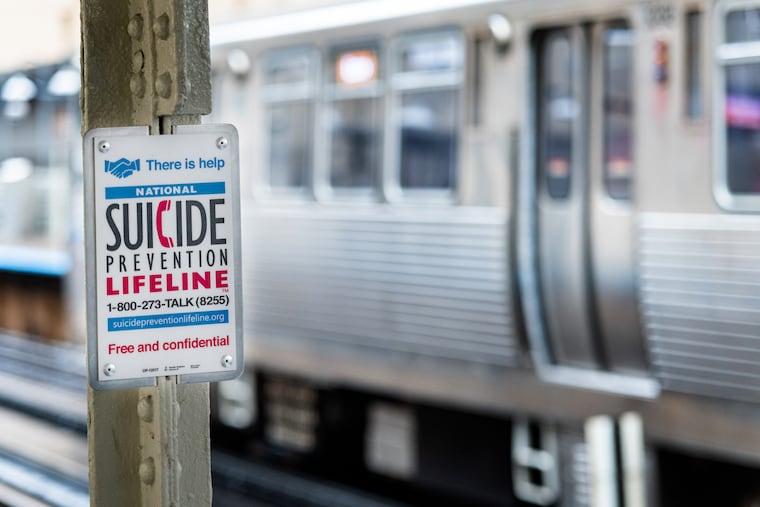Gun stores, isolation, and lack of hope fuel rise in U.S. suicides, study finds
Rural counties, especially those areas that are more sparsely populated and offer limited economic and education opportunities, saw the greatest increases. Communities with many veterans were affected greatly, too.

With suicides continuing to increase, a new study has taken a county-by-county look across the United States to identify factors associated with rising rates of adults taking their own lives.
Lack of insurance, social isolation, low incomes, and the presence of gun stores were among the variables that correlated to heightened rates of suicide, according to the study published Friday in the journal JAMA Network Open.
Rural counties, especially areas that are more sparsely populated and offer limited economic and education opportunities, saw the greatest increases. Communities with many veterans were affected greatly, too.
» READ MORE: What can be done about the rising suicides?
The researchers, who are affiliated with Ohio State and West Virginia Universities and Nationwide Children’s Hospital, hope that their findings can inform policy.
“Suicide is so complex, and many factors contribute, but this research helps us understand the toll and some of the potential contributing influences based on geography, and that could drive better efforts to prevent these deaths,” said lead researcher Danielle Steelesmith, a postdoctoral fellow at Ohio State University’s Wexner Medical Center.
“While our findings are disheartening,” Steelesmith said, “we’re hopeful that they will help guide efforts to support Americans who are struggling, especially in rural areas where suicide has increased the most and the fastest.”
Nationally, the suicide rate for adults ages 25 to 64 from 1999 to 2016 climbed by 41%, according to the study.
This study did not include older adults or teenagers and youths. While adults over age 75 is the only age group to have seen a decrease in suicide in recent years, the rate has risen sharply among teenagers and young adults. In fact, suicide is the second leading cause of death among young people, according to studies. One recent report found that 6,252 people ages 15 to 24 took their own lives in 2017, the highest number since 2000.
From 2013 to 2016, the years reviewed by the researchers, the suicides in large metropolitan areas averaged 17.6 deaths per 100,000 people. In rural areas, the overall rate was 22 deaths per 100,000 residents. The findings include data from more than 450,000 suicides.
Suicide rates were highest in rural counties in several western states and parts of Appalachia and the Ozark Mountains region.
» READ MORE: 'Blessed to be alive': How a Pa. woman survived shooting herself in the head
The Philadelphia area also has seen significant increases in suicide. The researchers compared the actual suicides in a given county to the expected number (based on the total population of a given county multiplied by the national suicide rate) and measured the difference between the two figures. From 1999 to 2016, researchers found that the difference between actual and expected numbers of suicides increased nearly 20% in Camden County, 40% in Burlington County, 50% in Bucks County, almost 52% in Chester County, nearly 37% in Delaware County, and 49% in Montgomery County. In Gloucester County, the overall rate dipped by about 7%. Philadelphia’s rate, with year-to-year fluctuations, stayed about the same.
While Philadelphia has numerous health care and social support institutions that help people in need,, Maria A. Oquendo, chairwoman of psychiatry with Penn’s Perelman School of Medicine, suggested the study’s finding of little change in the city’s suicide rate may be somewhat deceptive.
Given Philadelphia’s extremely lethal opioid epidemic, that seemingly flat rate may not reflect the overdose deaths here that were actually suicides, according to Oquendo, a past president of the International Academy of Suicide Research.
In research published last year in the New England Journal of Medicine, Oquendo found that a substantial portion of overdoses dismissed as accidental or undetermined are likely to be undercounted suicides.
“Our estimates are 30% and probably as high as 40% of those opioid deaths that are classified as accidental are actually suicides,” Oquendo said.
In the hardest-hit counties, suicides were between two and four times more than what would be expected, according to the findings. In Pennsylvania, Carbon, Lackawanna, Schuylkill, and Wyoming Counties fell in the high range, although at the lower end.
The counties with especially high suicide rates, the research showed, tended to share factors often associated with despair and a dearth of hope, such as poverty and underemployment, as well as social fragmentation and lack of support. These factors tended to be found more in rural areas, suggesting the need for strategies to enhance economic support, coping skills, and outreach to people at risk of suicide, according to the authors.
Suicide in urban counties, however, was more linked to the presence of gun shops, noted Cynthia Fontanella, a study coauthor and associate professor of psychiatry at Ohio State.
“The data showing that suicides were higher in counties with more gun shops — specifically in urban areas — highlights the potential to reduce access to methods of suicide that can increase the chances an at-risk person will die,” Fontanella said.